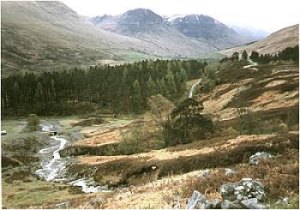

|
|||||||||
|
|
|
|
|
|
|
|
|
|
|
|
February 28th 1991 |


|
Old Lizzie Lothian
Looking down the glen at Glen Lyon. Picture by Chas Webb “Old Lizzie Lothian lived in the only black house I can remember seeing in the Glen. The house was at Invervar, not far from the present school and three or four miles from Woodend, and quite near the roadside. The house was indeed black inside and out, and Lizzie with it from years of smoke. The chimney was a hole in the roof with a large canopy coming down over the fire to draw the smoke up. The fire itself was placed on large stone slabs at floor level. There was an iron swey placed somewhere in the centre of the canopy with a hook suspended to hang a pot or kettle for cooking. The walls were of unworked stone and the roof of thatch; they say that a dozen pairs of hands making light work could put up a black house in a day. There were two rooms, one for the sleeping quarters and the other the living space where Lizzie moved about in the perpetual stinging smoke of a wood fire to the sound of her clucking and cackling hens. They were housed in a corner of the roof with an opening where they went in and out as they pleased. There was no sanitation; her water supply came from a tap which she shared with a few neighbours. Lizzie was old but had kept her faculties and had a good knowledge of the use of herbs. When she was young she used to supervise the collection of lichen used in dying the wool for spinning. She had a taste for the ‘barley bree’ and could always get a neighbour to fetch a wee spot on the grounds that it was for medicinal purposes. She also knew her Bible well and could quote long passages from memory. She had a direct link with the battle of Culloden, for she remembered talking to her grandfather who had fought there on Prince Charlie’s side. He was lucky to escape from the slaughter when the Government artillery wrecked the Jacobite formations and the Redcoats went in with bayonets. He and my father’s great-grandfather, Alan Stewart, owed their lives to the Hillman’s advantage on foot over a lowland pursuer on horseback. They dodged through a bog where the cavalrymen could not follow and made their way back to the Glen by many miles of devious hill paths. They were plain folk back among their own, and no one was looking for them. Lizzie was very interested in the Free Church and during the upheaval in 1900 my father had to go in and report on his way home. After evening meetings we often went with him to Lizzie’s house. We were a bit in awe of her as we used to think of her as like a witch and seeing an old fashioned broomstick by the fire we were sure she must be. She was a kindly old soul and we were always treated to a piece of black bun that she kept in a tin. We thanked her and said we would eat it on the way home but I’m afraid the birds of the air got it as it reeked of smoke. The one thing that really intrigued us was a pile of Illustrated London News she had put in a corner and let us look through. There were wonderful pictures in them of fine buildings and ladies in marvellous dresses. We were sometimes given copies to take home, and how proud we were to be able to cut out some of the pictures to take to school and boast that we got them from this marvellous old lady. Father disapproved of our mutilating the magazines, so we had to do the job on the quiet. Eventually Lizzie grew so old and frail that she could no longer stay by herself. She was taken to the institution at Logierait, 25 miles away in Strathtay, and there she died. She did not live long after her removal and was laid to rest among her ancestors in the very old churchyard at Invervar.” |

